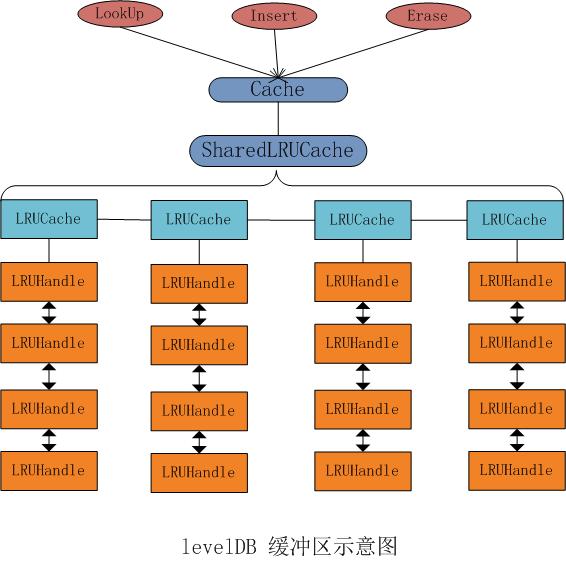Leveldb: Block Cache
February 25, 2017
Database LeveldbBlock Cache (util/cache.cc):
1. Introduction
Cache 的目的:减少磁盘IO,加快 CURD 速度。
leveldb 中的 cache 分为 Table Cache 和 Block Cache 两种,其中 Table Cache 中缓存的是 sstable 的索引数据,Block Cache 缓存的是 Block 数据(可选打开)。
leveldb 中支持用户自己实现 block cache 逻辑,作为 option 传入。默认使用的是内部实现的 LRU。
- 基于简单以及效率考虑,leveldb 中实现了一个简单的 hash table(LRUHandle),采用定长数组存放 node,链表解决 hash 冲突。每次 insert 后,如果 node 数量大于数组的容量(期望短的冲突链表长度),就将容量扩大2倍,做一次 rehash;
- LRU 的逻辑由 LRUCache 控制, insert 和 lookup 时更新链表即可;
- 由于 levelDB 为多线程,每个线程访问 cache 时都会对 cache 加锁。为了保证多线程安全并且减少锁开销,又将 LRUCache 再做 shard(ShardedLRUCache)。
整体来看:ShardedLRUCache 内部有 16 个 LRUCache(定长),查找 Key 时根据 key 的高四位进行 hash 索引,然后在相应的 LRUCache 中进行查找或更新。当 LRUCache 使用率大于总容量后, 根据 LRU 淘汰 key.

Declaration
// A single shard of sharded cache. class LRUCache { public: LRUCache(); ~LRUCache();
// Separate from constructor so caller can easily make an array of LRUCache void SetCapacity(sizet capacity) { capacity = capacity; } // Like Cache methods, but with an extra “hash” parameter. Cache::Handle* Insert(const Slice& key, uint32_t hash, void* value, size_t charge, void (deleter)(const Slice& key, void value)); Cache::Handle* Lookup(const Slice& key, uint32_t hash); void Release(Cache::Handle* handle); void Erase(const Slice& key, uint32_t hash);
private: void LRU_Remove(LRUHandle* e); void LRU_Append(LRUHandle* e); void Unref(LRUHandle* e);
// Initialized before use. sizet capacity;
// mutex_ protects the following state. port::Mutex mutex_; sizet usage; uint64_t lastid;
// Dummy head of LRU list. // lru.prev is newest entry, lru.next is oldest entry. LRUHandle lru; HandleTable table; };
struct LRUHandle { void* value;//存储键值对的值 void (deleter)(const Slice&, void value);//这个结构体的清除函数,由外界传进去注册 LRUHandle* next_hash;//用于hash表冲突时使用 LRUHandle* next;//当前节点的下一个节点 LRUHandle* prev;//当前节点的上一个节点 size_t charge; // 这个节点占用的内存 size_t key_length;//这个节点键值的长度 uint32_t refs;//这个节点引用次数,当引用次数为0时,即可删除 uint32_t hash; // 这个键值的哈希值 char key_data[1]; // 存储键的字符串,也是C++柔性数组的概念。 Slice key() const { // For cheaper lookups, we allow a temporary Handle object // to store a pointer to a key in “value”. if (next == this) { return (reinterpret_cast<Slice>(value)); } else { return Slice(key_data, key_length); } }//为了加速查询,有时候一个节点在value存储键。 };
class HandleTable { public: HandleTable() : length(0), elems(0), list(NULL) { Resize(); } ~HandleTable() { delete[] list; }
LRUHandle* Lookup(const Slice& key, uint32_t hash) {} LRUHandle* Insert(LRUHandle* h) {} LRUHandle* Remove(const Slice& key, uint32_t hash) {}
private: // The table consists of an array of buckets where each bucket is // a linked list of cache entries that hash into the bucket. uint32t length;//哈希数组的长度 uint32t elems;//哈希表存储元素的数量 LRUHandle** list_;//哈希数组指针,因为数组存储的是指针,所以类型必须是指针的指针 // Return a pointer to slot that points to a cache entry that // matches key/hash. If there is no such cache entry, return a // pointer to the trailing slot in the corresponding linked list. LRUHandle** FindPointer(const Slice& key, uint32_t hash) {} void Resize() {} };
Analysis
Cache类:一个抽象类,规范外部接口,用户可定义自己的 block cache,默认是调用
NewLRUCache返回一个 SharedLRUCache 对象。Cache* NewLRUCache(size_t capacity) { return new SharedLRUCache(capacity); }SharedLRUCache类:内部有16个(
kNumShards) LRUCache 缓冲区,该类主要作用仅是计算 hash 值,选择 LRUCache ,然后调用 LRUCache 的函数。LRUCache 类:真正的缓冲区数据结构,每个缓冲区都维护了一个 LRU 双向链表和 hash 表。链表的元素类型为 LRUHandle;hash 表中的元素是
LRUHandle *,用于快速判断数据是否在缓冲区中。LRUHandle 类:cache 中负责存储 key/value 的数据结构,是LRU 双向链表中的元素类型。
char key_data[1];为存储 key 的字符串,也是C++柔性数组的概念。void* value;为存储 valueHandleTable 类:为了保证哈希链的查找速度,尽量使平均哈希链长度为<=1。当元素的个数大于桶的数量时就重新 hash(resize 为当前 hash 表长度的2倍并 rehash),保证 hash 的时间复杂度为 O(1)。